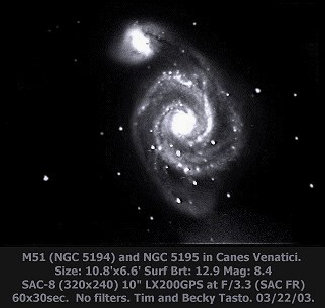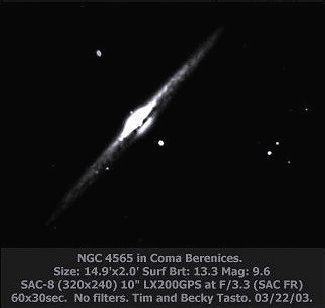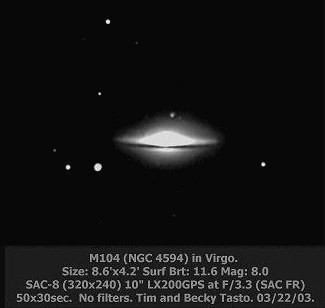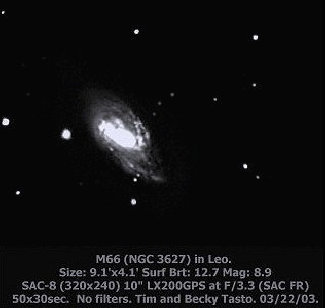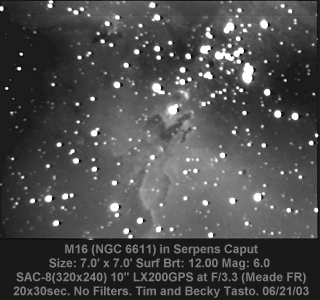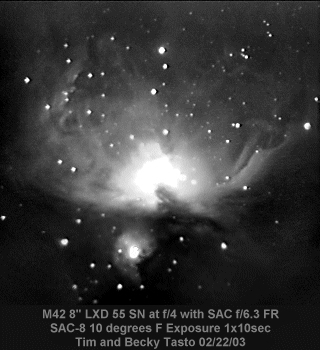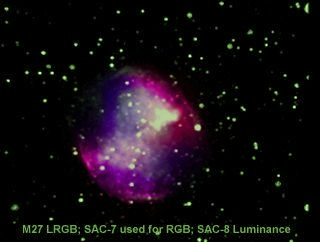| SAC-8 Images (B&W) (Please be patient while the images load)
(Adjust brightness and contrast on your monitor for best viewing) The images
of NGC
and Messier objects that follow were obtained with a SAC-8 CCD imager
and Meade 10" LX200 GPS, 8" Meade LXD55 SN, or Orion 80 ED telescopes.
The SAC-8 is a
reasonably inexpensive, 8-bit, peltier cooled device that is
remarkably
sensitive. For the relatively low price I, am extremely pleased with it
and will continue to use it. Some images may appear more than once. If
this is the case, they were taken with different telescopes, different
CCD imager settings, or processed differently. Note that the SAC-8,
which cost under $1000.00 US, is no longer being made.
Galaxies
These are 4 early shots with the SAC-8 and are small as we were using the SAC-8 in lo-res mode to increase sensitivity.
The M51 shot below was taken with a Meade 8" LXD55 SN. Although we normally use LX200's for imaging, the LXD55 looks like it is definitely CCD capable. 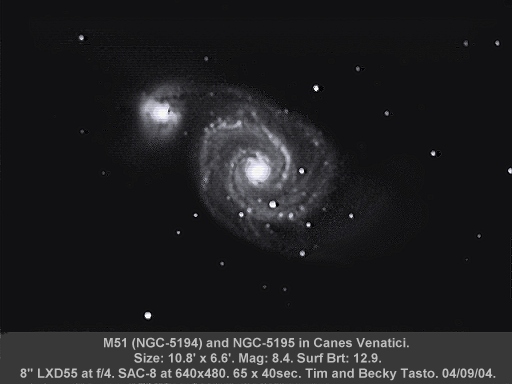
The
shot of M51 below is a mosaic of five images shot through a 10"
LX200GPS using a SAC F/6.3 Focal Reducer. We could not get the whole
galaxy to fit neatly on the chip without the mosaic.
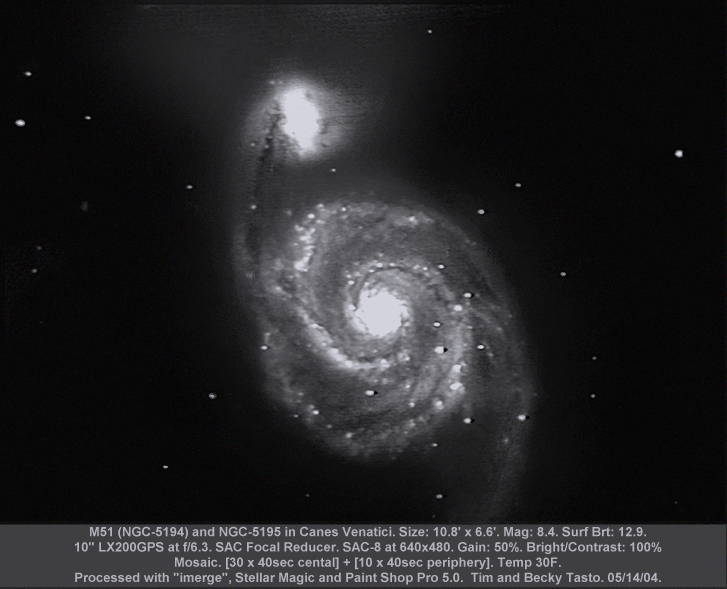 The
image immediately below is from the same raw image as the image
immediately above. The difference is the use of DDP in Stellar Magic on
the image below. Note the increase in detail in the image, especially
in the core and in the companion galaxy.
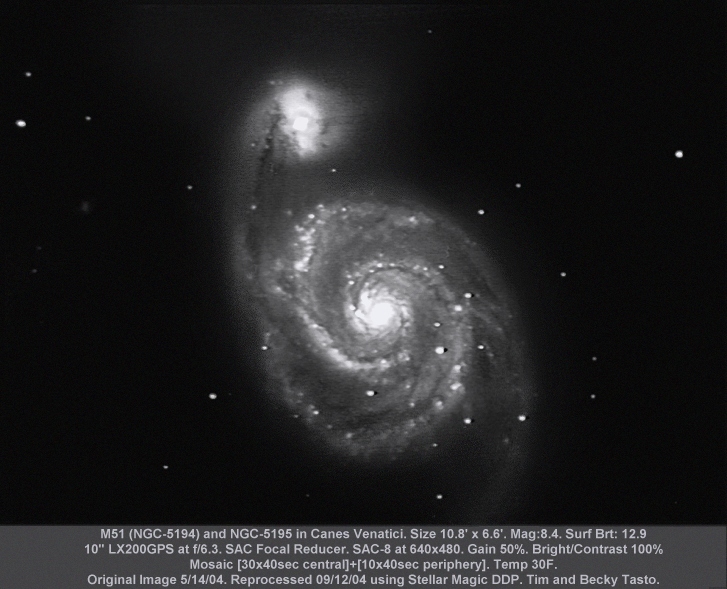
NGC-891 below was shot at my brother's house. He has great dark skies out there!
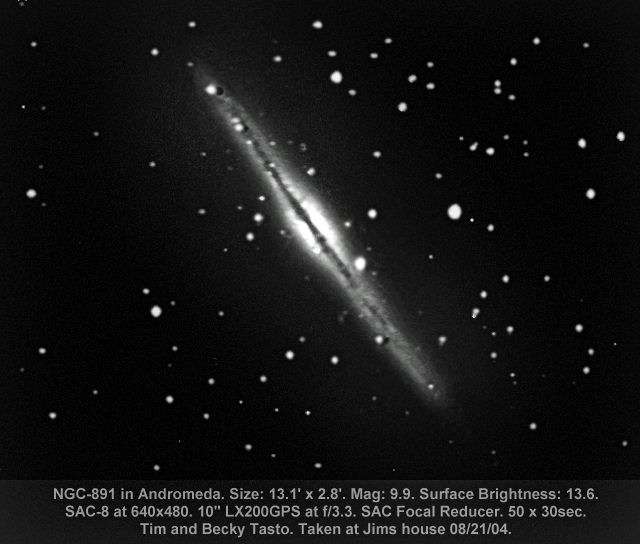 M63 below , the "Sunflower Galaxy". Really cool and interesting structure.
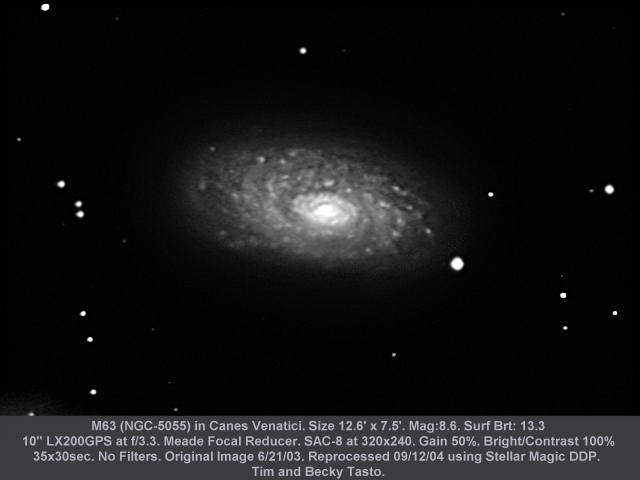 M64
below has a very bizarre structure. It is known as the "Black Eye
Galaxy" for reasons that become obvious when looking at it (or is it
looking at you?).
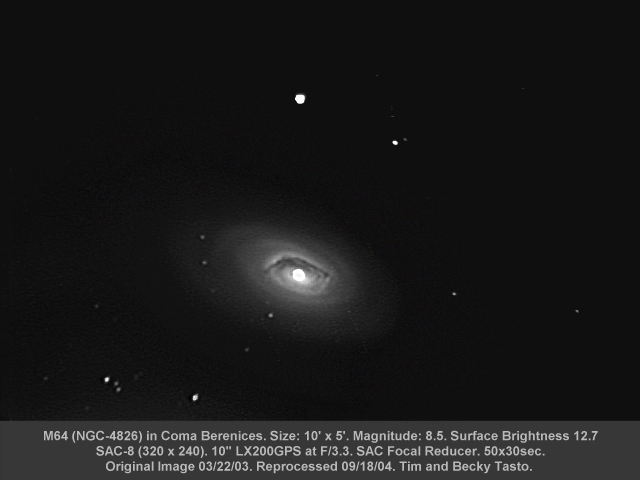
M82
below is an irregular galaxy that may have an explosion taking place in
the core. Though it cannot be seen clearly in the image below, some
shots of this galaxy show what appears to be matter being ejected from
the center of this galaxy.
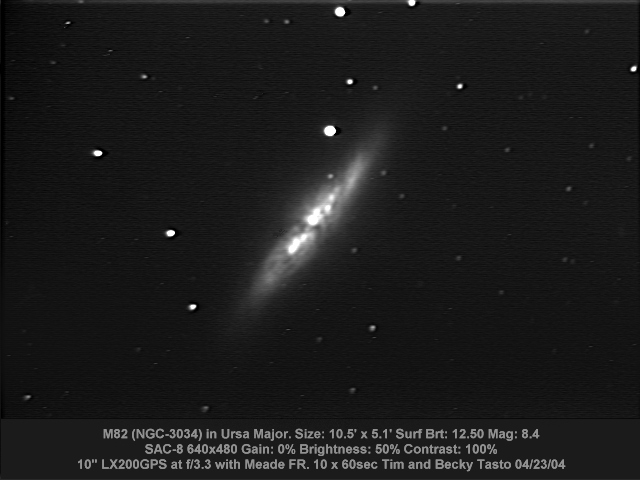 Below
are NGC-4631 and NGC-4627. Fighting clouds and haze, but still managed
to get a shot of these galaxies. Very interesting and irregular
structure.
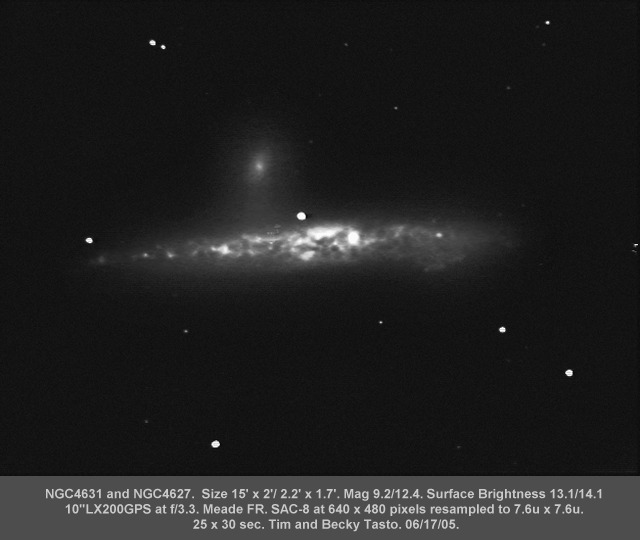 M81
and M82 below are not a mosaic. It is a single frame using an
Orion 80ED APO refractor with a native Focal Ratio of 7.5. A SAC-8 with
a SAC f/6.3 Focal Reducer was used to arrive at an effective Focal
Ratio of 7.5 * 0.63 = f/4.7. Additionally, the image was shot through a
fuzzy cloud (hence the "washed-out" appearance) and there was only time
to obtain a stack of 30 images at 25 seconds each. So...this one is
definitely worth trying again on a better night. This is a "first
light" shot with our new Orion 80 ED, which looks like it is going to
work out great for wide-field shots.
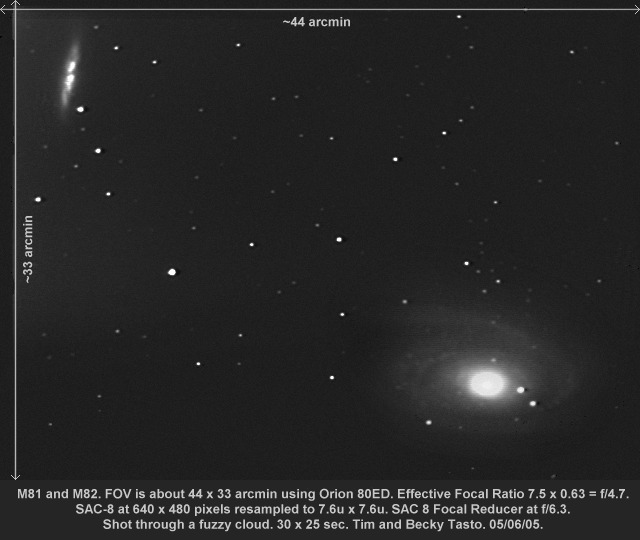 NGC-7331
(and friends) below is an interesting target because of all the
galaxies nearby. This shot is "OK" but it looks like I over-processed
it and there are optical artifacts on the stars. Oops! In any case, at
least it shows some detail and neighboring galaxies are clearly visible.
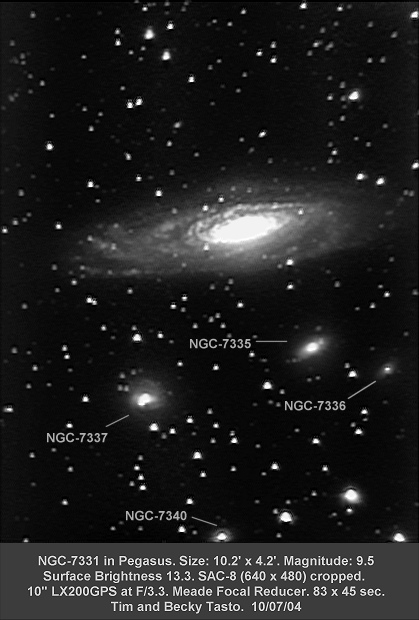 Nebula M57
(the "Ring Nebula") below is a very popular target for
astrophotographers and visual observers alike. Though it is not large,
it is bright enough that the ring structure is easily visible through
even a small telescope on a dark, moonless night. The ring is a result
of gasses ejected by the star that can be seen in the center of the
nebula.
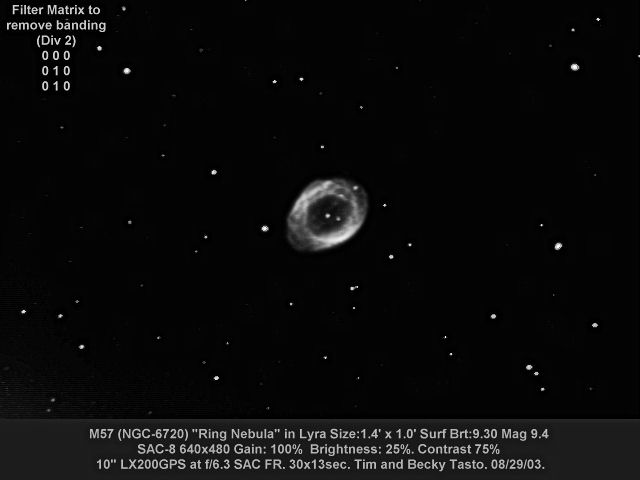 M57
below is a (rather sad) attempt at creating an LRGB image using color data from a
SAC-7b and Luminance from a SAC-8. I'd say its an "OK" image, but it'
was hard to keep the color balance right as the color data contained a
strong magenta component. It was still fun to play with the concept.
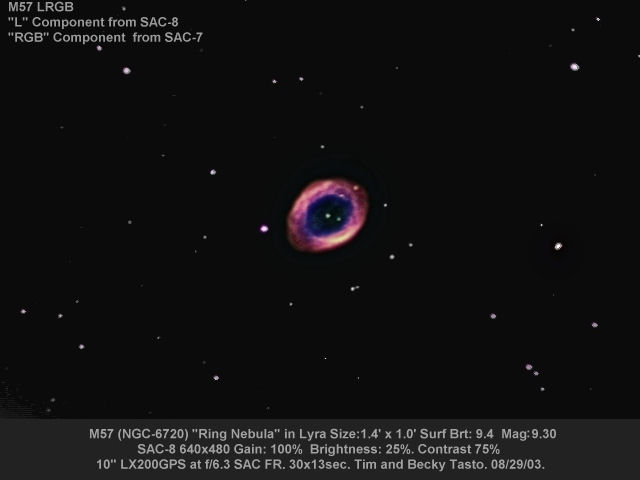 M27
below is another popular object for smaller telescopes on dark,
moonless nights. In fact, it can even be seen in a set of 7x50
binoculars if you know where to look. M27 is esentially the result of a
star that "burped-off" a layer that formed the bubble we now see. This
object is considerably larger than M57 above, but not quite as bright.
Stars in this image look just a little oblong to me. Tracking was
a bit off.
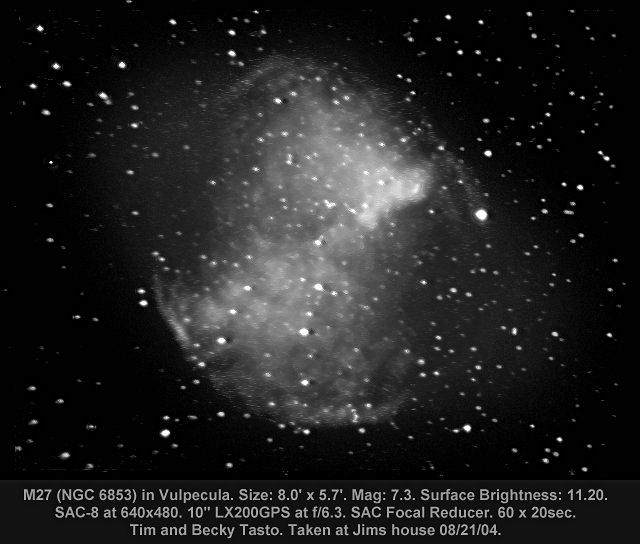 M1
(the "Crab Nebula") below is the remnant of an exploding star. It is a
bit difficult to see in a small telescope but on a dark, moonless night
it still can be found. My experience with this object is that it takes
an 8" scope or larger to see it "comfortably". The image looks a bit
"dirty". This is usually a result of not stacking enough images to
smooth-out the noise in the data. It was cold out.
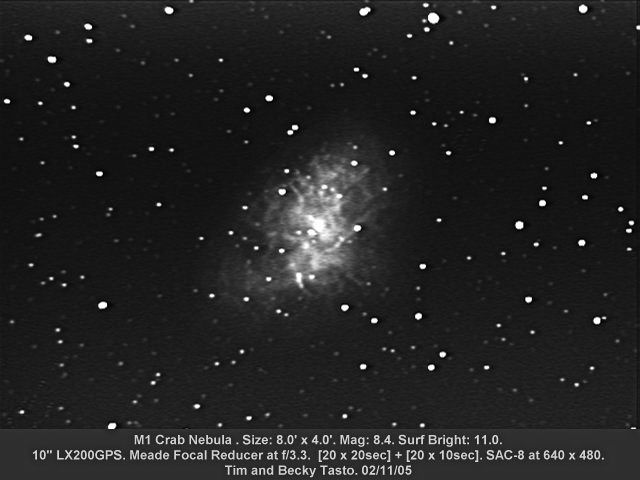 Below
are some miscellaneous images including M16, M27, M42, and a (bad)
LRGB attempt of M27. All of these objects are easily visibly even
in smaller scopes of 4" or less. M42 is the famous "Great Orion
Nebula", which is visible to the naked eye if you look for a fuzzy
patch in Orion's sword. It is easily visible (and quite beautiful) in
binoculars. M16 was made famous because it was one of the first objects
imaged by the Hubble Space Telescope and it appeared in Newspapers
everywhere as the "Pillars of Creation".
Globular Star Cluster M13 M13 below (the "Great Hercules Cluster) is another beautiful object that is easily visible in binoculars or a small telescope.
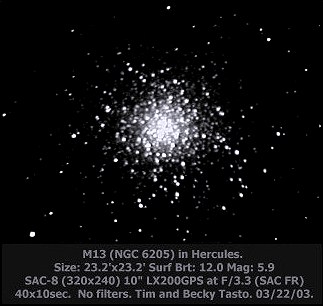 Return to Deep Space Imaging and Astrophotography Main Page
All images copyright (c) Tim Tasto and Becky Tasto
NGC4631 , NGC4565 , M51 , M104 , M66 , M51 , NGC891 , M63 , M81 , M82 , NGC7331 , M57 , M27 , M16 , M42 , M13, M1
NGC-4631 , NGC-4565 , M-51 , M-104 , M-66 , M-51 , NGC-891 , M-63 , M-81 , M-82 , NGC-7331 , M-57 , M-27 , M-16 , M-42 , M-13, M-1 |
||||||||||
